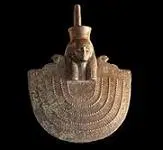 The etymological root of aegis is found in aigós , a word from the Greek language that can be translated as "goat" . This term came to Latin as aegis , which passed into Spanish as aegis .
The etymological root of aegis is found in aigós , a word from the Greek language that can be translated as "goat" . This term came to Latin as aegis , which passed into Spanish as aegis .
According to the first meaning mentioned in the dictionary of the Royal Spanish Academy ( RAE ), the aegis is the skin of a goat called Amalthea which, decorated with the head of Medusa , represents the goddess Athena .
There are multiple versions of the aegis according to the different mythologies developed regionally. It is said that Zeus used the skin of the animal that had suckled him (the goat Amalthea ) as a shield when he fought against the giants. Another legend indicates that the aegis was carved by Hephaestus for Zeus , with the head of Medusa in its central area. Zeus , in this context, used to lend this shield to Athena .
If we take this meaning as a reference, we can understand the expression "being under the aegis", which is used in our language to refer to a situation in which we find ourselves protected, either because someone defends or protects us or because we are in a position that isolates us from danger.
In Egyptian mythology , the aegis was a type of necklace with a lioness head worn by the goddess Bastet . This type of object is also present in Norse mythology as the helmet used by the dwarf Fafner .
Bastet was a goddess worshiped by ancient Egyptians since the Second Dynasty , which began around 2890 BC. C.; It offered harmony and protection for temples and homes. In Lower Egypt, which corresponded to the Delta region of the Nile River, she was the goddess of war, before the cultures were unified.
Some of the many representations of the goddess Bastet show her with an aegis in one hand and a ceremonial sistrum in the other. On the other hand, we have ancient Nubia , a region located to the south of Egypt and borders northern Sudan, which developed a mythology very similar to the Egyptian one in a large number of aspects to the point that scholars have been debating for decades. about the true source of certain concepts of religion, since they are present in both cultures .
A representation of the goddess Isis with an aegis was discovered in Sudan. There are several transliterations of his original name, which translates as "throne", a term that represents the hieroglyph he wore on his head. She is known as the goddess of motherhood and birth .
 By extension of these meanings, an aegis can be called a shield (a defensive weapon that protects the body) or specifically a buckler (a round shield to protect the chest in the middle of a sword fight).
By extension of these meanings, an aegis can be called a shield (a defensive weapon that protects the body) or specifically a buckler (a round shield to protect the chest in the middle of a sword fight).
It is even possible to refer to an aegis as a defense or protection at a general level. In ancient times, the aegis was an emblem of the invulnerability guaranteed by the gods .
In the video game Xenoblade Chronicles 2 , developed by the Japanese team Monolith Soft and published by Nintendo for its Switch console, the term aegis is used to designate a series of legendary characters who play a very important role in the story. They belong to the Blade class, artificial life forms that accompany pilots and grant them weapons, arts and special abilities, among other forms of support .
Among the features that distinguish the aegis from the normal Blades, we can say that they have a different shade (for example, the characters Mythra and Pyra are green), and they have a cross-shaped crystal .
